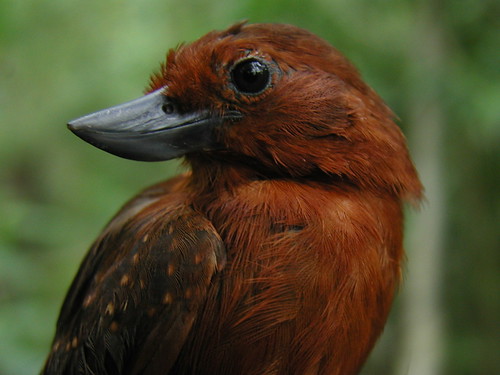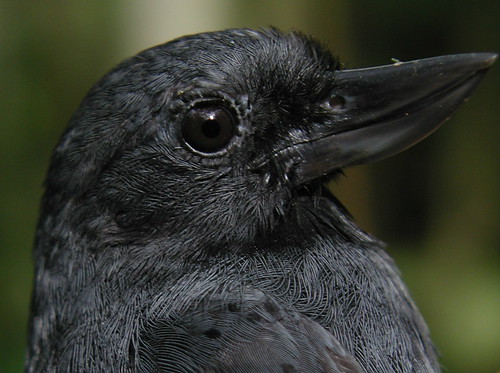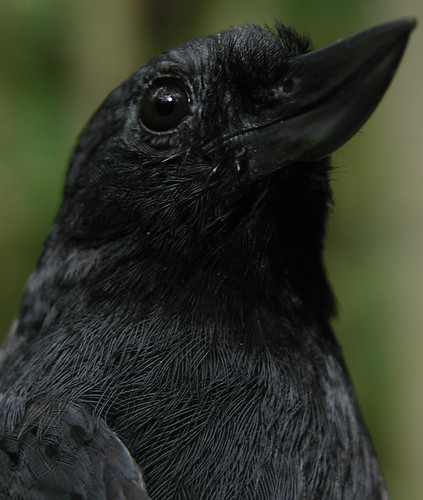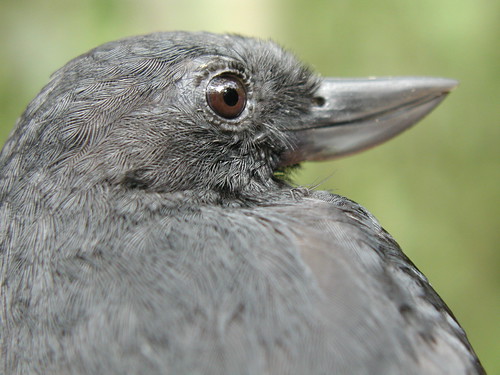tags: recurve-billed bushbird, Clytoctantes alixii, ornithology, birds, avian, endangered species
Female Recurve-billed Bushbird, Clytoctantes alixii. More images below the fold.
Image: Chris Sharpe 2004 [larger].
Chris Sharpe emailed me this following statement about the Recurve-billed Bushbird rediscovery, which I quote in full. I also present Chris's original 2004 images here, although some of the images will re-appear on this site soon (one will be the featured image for the next issue of Birds in the News, for example).
The Recurve-billed Bushbird, Clytoctantes alixii, has been in the popular birding news, as well professional ornithological discussions, after the press release in May of the "first photographs" of the bird. Since this topic continues to developed, we felt it appropriate to clarify some points raised in those discussions and to that end a resume of our experience in Venezuela with this bird appears below.
After three trips to the Venezuelan foothills of Sierra de Perijá, Recurve-billed Bushbirds were heard, then seen and captured in April 2004 during a four man Conservation International (CI)-financed RAP expedition (consisting of ornithologists Miguel Lentino, Jorge Perez-Eman, Irving Carreño and Chris Sharpe) under the auspices of the Venezuela Audubon Society, the Phelps Ornithological Collection and the Tropical Zoology Institute of the Central University of Venezuela (IZT-UCV). At that time, we were fortunate enough to obtain what we had presumed were the first photographs of the species. Chris Sharpe returned with Mark Sokol and Lanie Langlois in August 2004 to obtain what we believed to be the first sound recordings, more detailed behavioural notes and to make a more accurate assessment of conservation issues. The 2004 search took place in an area in which local Colombian farmers had reported seeing the Bushbird regularly. Much of the groundwork for the Venezuelan rediscovery was carried out by Maracaibo-based birder, José Gustavo León, who was the first to find access to the Bushbird habitat and helped considerably with our expedition, as well as accompanying Sokol and Sharpe on our second visit to Perijá in June 2003. The local Colombian farmers were crucial to our fieldwork since they were the first observers, originally claiming that the Bushbird was a regularly inhabitant of their agricultural plots. Sr. Juan Torres Yanes and his wife Virgelina and sons Ramón, Yoner, Irlen, Eduard and Naiber were particularly helpful and Eduard accompanied us to several sites at which the Bushbird had apparently been seen.
Male Recurve-billed Bushbird 1, Clytoctantes alixii.
Image: Chris Sharpe 2004 [larger].
Although it spread a bit in the Neotropical birding world, the news of our encounter with the species in Venezuela was kept relatively quiet for several reasons, not least of which were the fact that we did not really want numbers of birders to immediately descend on a potentially sensitive area, and also because we planned to return to obtain more data for publication. We notified colleagues at BirdLife International immediately, tipped off a couple of Venezuelan birders who we knew would be interested and gave copies of the initial recordings to people who might have been able to search for the species elsewhere. Later, we sent some basic information to Stuart Butchart of BirdLife for the IUCN Red List. This was posted as part of a BirdLife Species Factsheet and documented in the Neotropical Bird Club's inaugural issue of Neotropical Birding [free PDF]. Slightly more detailed information will also appear in the forthcoming 3rd edition of the Venezuelan Animals Red Data Book published by Provita and Fundación Polar, drafted in 2004 / 5.
We should point out that Colombian ornithology student Oscar Laverde refound Bushbirds in Norte de Santander, Colombia in July 2005. The birds were subsequently studied in detail by Laverde, F. Gary Stiles and ornithology students of the Natural Sciences Institute of the National University of Colombia. Their findings have just been published in an excellent Spanish paper in OrnitologÃa Colombiana, which is available to the public [free PDF]. Their findings tally closely with our own, although there are some differences. We are now working to publish this and other exciting results of recent expeditions to Perija.
Initially, at least, the outlook for the Bushbird on the Venezuelan side appears good, and much better than we had guessed prior to 2004. Having said that, a considerable area of extremely important, uninhabited primary forest is rapidly being invaded in the foothills of this range where the forest is being felled to plant short-term cash crops. There appears to be little attempt to control or regulate illegal deforestation there on the part of government agencies and political support for the invasion. The forests there are home to several other interesting species, some of which are of conservation concern and there are several undescribed taxa including a probable Tapaculo (Scytalopus) species as well.
Jorge Pérez-Eman
Chris Sharpe
More reading and some images from 2005 and later





Hedwig,
These are beautiful pictures of an intriguing bird. I stop by your blog daily to see what new and interesting things you have ginned up.